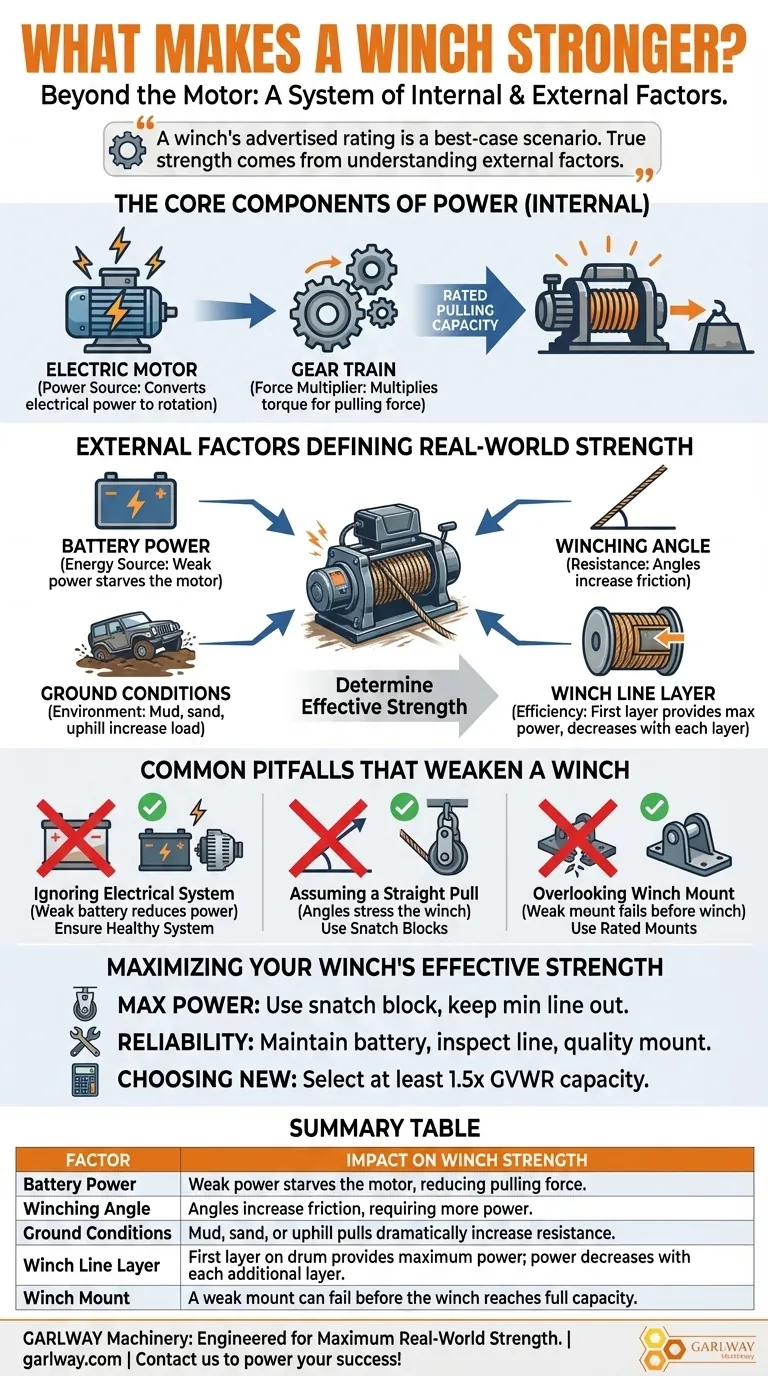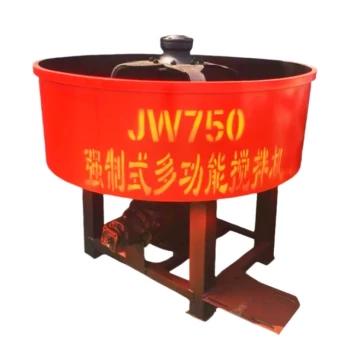A winch's strength is defined by far more than its motor. While the power of its electric motor and the reduction ratio of its gear train create its rated pulling capacity, a winch's effective strength in a real-world scenario is dictated by a system of external factors. These include your vehicle's electrical system, the winching angle, and the physical conditions of the recovery.
A winch's advertised rating represents a best-case scenario—a straight, single-line pull with only the first layer of rope on the drum. True strength comes from understanding how external factors like power supply, line angle, and ground conditions can drastically reduce its real-world pulling power.

The Core Components of Power
A winch's rated capacity begins with its internal hardware. Two components work together to turn electrical energy into immense pulling force.
The Electric Motor
The motor is the heart of the system. It converts electrical power from your vehicle's battery into the rotational speed needed to begin the winching process.
The Gear Train (The Force Multiplier)
The motor alone does not create the necessary force. Its high-speed, low-torque rotation is fed into a gear train. This set of reduction gears multiplies torque (pulling force) at the expense of speed, allowing a small motor to pull thousands of pounds.
External Factors That Define Real-World Strength
The winch's internal components only set the potential. The following factors determine how much of that potential you can actually use in a recovery situation.
The Critical Role of Battery Power
A winch is an energy-hungry device. A weak or undersized battery, poor connections, or a non-running engine will starve the winch motor of the amperage it needs to reach its full potential.
Winching Angle and Resistance
A winch is strongest when pulling in a perfectly straight line. Every degree of angle, either horizontally or vertically, introduces friction and resistance that the winch must overcome in addition to the load itself.
The Impact of Ground Conditions
The environment is a massive variable. Pulling a vehicle through deep mud, sand, or uphill dramatically increases the required pulling force, effectively making the winch work much harder.
Winch Line Characteristics
A winch's pulling power is highest on the first layer of line wrapped around the drum. As more line spools onto the drum, the gear ratio effectively changes, reducing pulling power with each subsequent layer.
Common Pitfalls That Weaken a Winch
Understanding common mistakes is key to ensuring your equipment performs when you need it most. Avoiding these pitfalls is as important as choosing the right winch.
Ignoring Your Electrical System
Installing a powerful winch without ensuring your battery and alternator can support it is a frequent error. A winch can only be as strong as the power source feeding it.
Assuming a Straight Pull
Many recovery situations are not ideal. Failing to account for angles and using tools like snatch blocks to correct them can over-stress the winch and reduce its effective power.
Overlooking the Winch Mount
The winch mount is the anchor for the entire system. A mount that is not properly rated or secured to the vehicle's frame will flex or fail long before the winch reaches its maximum pulling capacity.
Maximizing Your Winch's Effective Strength
Use these principles to guide your decisions, whether you're buying a new winch or using one you already own.
- If your primary focus is maximum pulling power: Ensure your vehicle is running, use a snatch block to double your force, and keep the minimum amount of line spooled out for the pull.
- If your primary focus is reliability and safety: Invest in a high-quality winch mount, maintain a healthy vehicle battery, and regularly inspect your winch line for damage.
- If your primary focus is choosing the right new winch: Select a winch with a rated capacity of at least 1.5 times your vehicle's Gross Vehicle Weight Rating (GVWR) to account for real-world resistance.
Understanding these factors transforms a winch from a simple tool into a predictable and reliable recovery system.
Summary Table:
| Factor | Impact on Winch Strength |
|---|---|
| Battery Power | Weak power starves the motor, reducing pulling force |
| Winching Angle | Angles increase friction, requiring more power |
| Ground Conditions | Mud, sand, or uphill pulls dramatically increase resistance |
| Winch Line Layer | First layer on drum provides maximum power; power decreases with each additional layer |
| Winch Mount | A weak mount can fail before the winch reaches full capacity |
Ensure your next project has the reliable power it needs. GARLWAY specializes in construction machinery, offering robust winches, concrete mixers, and concrete batching plants designed for the demanding conditions faced by construction companies and contractors globally. Our equipment is engineered for maximum real-world strength and durability. Contact us today to discuss how GARLWAY can power your success!
Visual Guide

Related Products
- Electric and Hydraulic Winch for Heavy Duty Applications
- Warn Winch Windlass Boat Trailer Winch
- Electric 120V Boat Winch by Badlands
- Best 18000 Pound Drum Anchor Trailer Winch
- 12000 lb Heavy Duty Electric Boat Winch
People Also Ask
- How to power an electric winch on a trailer? Choose the Best Method for Your Setup
- Can an electric winch be used as a hoist? Understand the Critical Safety Differences
- Do electric winches have brakes? Essential Safety for Your Heavy-Duty Pulling
- How is an electric winch powered? Unlock the Power Conversion System for Heavy Lifting
- How does the electric winch work? Unlock the Power of Force Multiplication


















